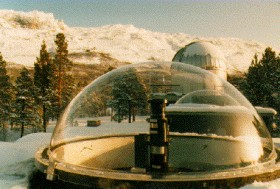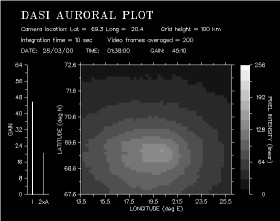
|
DASI
|
 |

|
DASI
|
 |
 The Digital All-Sky Imager (DASI) consists of a low-light-level
television camera fitted with an all-sky lens (180 degree field of
view) and a narrow band interference filter at 557.7 nm. The main
purpose is to study the relationship between the aurora and
ionospheric electric field patterns as observed by the
The Digital All-Sky Imager (DASI) consists of a low-light-level
television camera fitted with an all-sky lens (180 degree field of
view) and a narrow band interference filter at 557.7 nm. The main
purpose is to study the relationship between the aurora and
ionospheric electric field patterns as observed by the
![]() STARE and
STARE and
![]() EISCAT radars. Collaborative
studies with other experiments such as
EISCAT radars. Collaborative
studies with other experiments such as
![]() HEATING and the IRIS are also
undertaken. The instrument began recordings in 1993. The lens and
filter can be changed. Current options include a 90 degree field of
view lens and 630 nm filter.
HEATING and the IRIS are also
undertaken. The instrument began recordings in 1993. The lens and
filter can be changed. Current options include a 90 degree field of
view lens and 630 nm filter.
|
DASI publications by MPS members |
 A 486-PC controls the experiment which runs entirely
automatically. The computer determines the safe night-time recording
intervals using sun and moon position prediction algorithms. The lens
shutter and camera gain are also controlled by the computer. Video
images are averaged digitally in time (typically 10 seconds) using
real-time frame grabber and image processing hardware. The image is
then transformed into a geographic grid of 67.6-72.6 North in steps of
0.1 degrees and 13.5-26.0 East in steps of 0.25 degrees at an altitude
of 100 km. The resulting digital image is then saved to a high
capacity magneto-optical disk for later analysis. Simultaneous video
recordings may also be performed. Operational parameters such as the
integration time and the transform grid are user defined.
A 486-PC controls the experiment which runs entirely
automatically. The computer determines the safe night-time recording
intervals using sun and moon position prediction algorithms. The lens
shutter and camera gain are also controlled by the computer. Video
images are averaged digitally in time (typically 10 seconds) using
real-time frame grabber and image processing hardware. The image is
then transformed into a geographic grid of 67.6-72.6 North in steps of
0.1 degrees and 13.5-26.0 East in steps of 0.25 degrees at an altitude
of 100 km. The resulting digital image is then saved to a high
capacity magneto-optical disk for later analysis. Simultaneous video
recordings may also be performed. Operational parameters such as the
integration time and the transform grid are user defined.
| © 2006, Max-Planck-Institut für Sonnensystemforschung, Lindau |
Kosch 14-05-1999 |